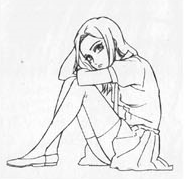But how did you devise to create good work out of a small number of drawing sheets?
That's the area of editing or storyboarding.
We devise camera blocking to make the film look good.
The ultimate was in the sixth episode.
I think it was 600 sheets.
If I recall correctly, Mackie (Kazuya Tsurumaki) created a storyboard with a little less than 700 sheets (697 sheets).
Making a cut of a character speaking a line takes at least four pictures, three of which are just moving mouths and one of which is a still picture.
If there are 200 cuts that require four pictures, it already takes 800 pictures.
That is less than 800. That means that he didn't even make those talking cuts.
He made cuts with the character showing his back to us, or cuts only with backgrounds, or a monologue.
And even if you don't move the characters, if the storyboarding is good and the editing is good, you can make it look good.
He tried it in the second half of "Eva" and sharpened it in "Kare Kano."
I think the idea was that since the original work was a manga, there would be something relatable about that methodology.
Is your role to include a cut that clearly shows movement in such a way that the number of sheets is reduced?
Yes, that's right.
There was one part in episode 6, which Mackie storyboarded, that had a bit of movement in it.
By adding movement to a part, it creates a contrast to the overall effect.
For episode 8, I drew half of the storyboards, and Saeki drew the other half.
With a few minor adjustments and corrections, I direct the animation.
Saeki is the type of creator who sometimes adds movement.
He adds more movement than Anno does.
I tend to add more, but I don't think I added that much movement in episode 8.
I used line drawings and reduced the number of sheets by using cartoon-like processing to make it more impressive.
“Kare Kano" was created based on the premise of an anime based on a manga.
It was not a conscious effort to create something different from the manga, but rather an extension of the manga.
Even in this situation, I would say that Kazuhiro Takamura has specialized in drawing.
He went in the direction of creating beautiful pictures even if the animation was stopped.
Which of the cuts would you have added the most movement to?
Episode 26 is really just a bunch of still pictures (laughs). So it should be one of episodes 1, 8, 13, or 18.
Hmmm...I couldn't immediately recall a cut that was appealing by adding movement to it.
I was drawing the storyboards with a sense of how to achieve a certain goal, and I was also conscious of where to place the climax in my drawings.
I was rather overwhelmed by the wonderful BG-only* pictures in the art department, saying, "Wow!”
There were so many of them, weren't there? School buildings, traffic lights, and so on.
The traffic lights were even painted in the drawing…
*The method of showing one cut with only background drawings
If you had to pick one, which one would it be?
I guess that episode 13 is well balanced. Masahiko Otsuka is in charge of the storyboarding and direction, and I think there is a good balance between the various aspects.
The episodes with movements are the episodes that Imaishi is in charge of.
In addition to that, episode 10 had quite a bit of movement.
As far as I can remember, Fumitoshi Oizaki from Junichi Sato's team did a very good job in episode 18, and the depiction of cherry blossoms by Yamaguchi, which I mentioned earlier, was also very good.
What impressed me was the movement of Yukino's hips. Not only in that episode, but I was watching the anime thinking how well Yukino's hips were moving.
I think it's Anno's taste.
Like, "The hips are the most attractive part of a woman's body."
The only character in "Kare Kano" with big boobs is Rika. And that's only in the anime (laughs).
Then, as far as adding movement, it's about how the skirts of the school uniforms move.
At the time, I studied the movement of the hem of the skirt and drew it.
The traditional or common movement is to swing it from side to side.
But actually, it doesn't swing from side to side so much, but vertically.
I found the hip side of the skirt going inward just as the person stepped out. I was like, "Oh, I got it!" (laughs).
I had a similar conversation with Toshiyuki Inoue when we had an interview for "Sayo Asa (Maquia: When the Promised Flower Blooms)”.
At that time, I also mentioned that in the case of long skirts, the fabric wraps around the legs which makes the movement more complicated and difficult to draw.
☆For more on Hiramatsu's challenges in "Kare Kano," see also the LD re-recording and the way the music was added in episode 18.

The line drawing for the DVD volume 4 released in 2005. Hiramatsu's favorite Maho.
・・
